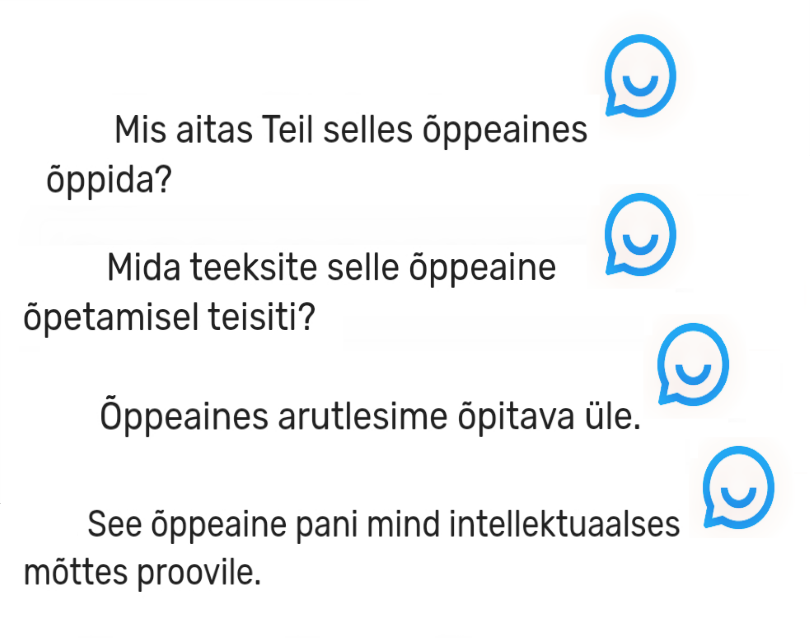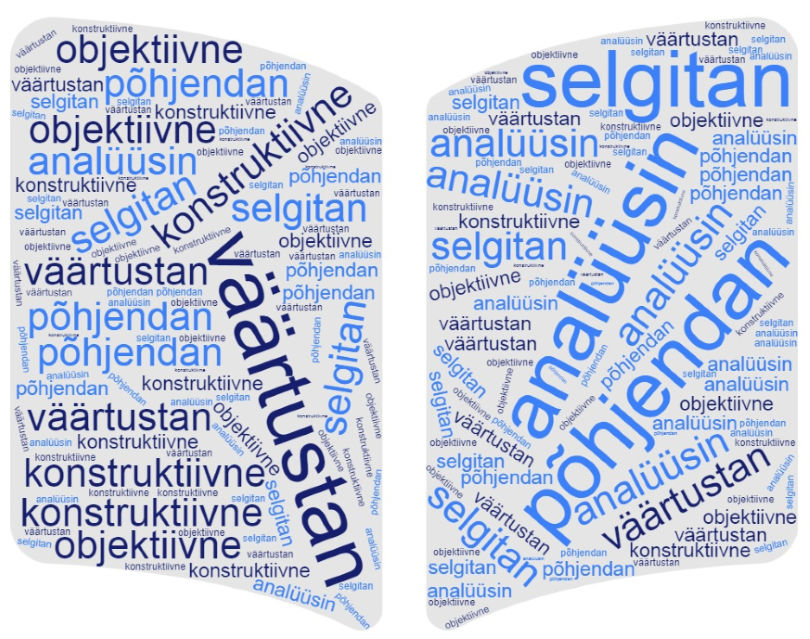1. Which personalisable data are stored?
The respondent's ID value (a code automatically generated by the database) makes personalisation possible when feedback is given. The respondent's ID value is uniform throughout the information system; it is associated with the personal data, study results, data of the student place, etc.
2. How is the feedback given to a course or a curriculum saved in SIS?
The student’s answer to a question is saved in the SIS data table in a pseudonymised form. This means that on each line in the data table there is an answer (a variant of a multiple-choice question or a comment) with the respondent's ID value. Personal data cannot be associated with a respondent without using additional information.
3. For what purpose are these data stored?
According to § 3 subsection 7 clause 6 of the Standard of Higher Education, the university must have a support structure for academic staff and support systems for students. One of the measures ensuring the quality of teaching is student feedback. In degree studies, the university has established a procedure for gaining feedback and taking it into consideration. The results of the feedback are necessary for the state to assess the quality of higher education. A higher education establishment's right to continue teaching depen on this feedback. Therefore, the University sends the feedback results to the Higher Education Quality Agency (Higher Education Act, § 37). The data received from the feedback are processed according to article 6 subsection 1 clause e of the General Data Protection Regulation, because processing of data is necessary to fulfill the obligation to provide teaching services.
It is necessary to store the respondent's ID value with their answers for the following reasons:
- feedback and the respondent’s ID value are connected so that the information system can check whether the students have fulfilled their obligation to provide feedback on the required number of courses according to the Procedure for Asking and Taking Into Account Feedback in Formal Education. In exceptional cases, it can be necessary to identify an individual respondent to ascertain why he or she has had problems using SIS (for example the respondent says that he or she has assessed the required courses, but for some reason still has restrictions in SIS);
- in the last ten years, students have asked to delete feedback in order to complete the questionnaire again, as for some reason they have erred in the assessment of a course or lecturer (for example they have saved their feedback only to discover that they had assessed the wrong course or lecturer);
- the university conducts research on studies and teaching. Time series of data and the possibility to associate data from different databases are necessary for the analysis of results and research;
- teaching staff members and students have asked for differentiation of feedback results in SIS according to different variables (for example that teaching recommendations for the course be differentiated according to the students’ curricula, groups and study results).
4. Where are the data stored and who can personalise the answers?
Answers to feedback questionnaires are stored on SIS servers located in the University’s own server rooms and are kept by the Information Technology Office. The respondent's ID value, the ID value of the assessed syllabus and the learner’s answers are saved in a database table. The respondent's ID value corresponds to other data in the table that identifies that person (by name). Associating the feedback answer with a concrete person is possible only if there is a legal basis for it, and technically this can be done by persons who have the right of access as part of their work duties. Association of data in data tables is done only if there is substantiated need for it. Someone’s personal wish to get information is not substantiated need.
5. Who has the right to demand personalisation of feedback?
Data usable to identify a learner who has given particular feedback can be required by a court if the comment has violated someone’s right to a good name. An example of damaging a person’s good name would be giving an inappropriate value assessment. In addition, use of data to identify a person can be required from the university by the police or by the prosecutor’s office if the comment hints, for example, at a crime, and the data are necessary to establish the truth in a criminal case (Information Society Services Act, § 11, subsection 5; Code of Criminal Procedure, § 215, subsection 1).
To prevent the need for the personalisation of data, the University asks the learners to read the good practice of giving feedback before answering. The Office of Academic Affairs can delete answers ignoring the good practice. System is also in place to find inappropriate comments on SIS and to prevent them being published.
6. In how many cases has feedback been personalised and for what reasons?
The University has identified the people who gave feedback for the following reasons:
- learners themselves informed the Office of Academic Affairs that when completing the questionnaire they erred when selecting a course or lecturer and have asked that their assessments be deleted so that they can give the correct feedback. There have been ten such cases in ten years.
- In one case the University supplied the name of the person who has given feedback to the Tartu County Court during court proceedings.
- In one exceptional case a learner's feedback was deleted when their study result was cancelled was cancelled.
When members of teaching staff have asked the Office of Academic Affairs to delete offensive comments about them from SIS, these comments are removed without being associated with learners who made them. The problematic comment is found in the data table of answers (using the ID value of the assessed syllabus, the number of the question and some words from the comment), and is deleted.
7. How long are answers to feedback questionnaires and personalisation data stored?
The University has is no fixed term for deleting published feedback, but questions of data archiving are currently being discussed at the University. At a meeting in autumn 2019, universities and the Information Technology Foundation for Education made a proposal to the Ministry of Education and Research to create a united archive (repository) of education data in Estonia as education data cannot be deleted after 25 years. Still, the data cannot be stored in the same information system for decades as all the data need not be stored in a personalisable form, and storing of data becomes burdensome for the information system (the SIS of the University of Tartu has been operating for 19 years). Questions of data archiving are wider ranging than feedback data and SIS and involve other information systems.
As for displaying of feedback, the Office of Academic Affairs would like to decrease the number of semesters for which feedback is visible for everyone in SIS. Current feedback from the last five years must be available for the attestation of the teaching staff. Recommendations for future students become outdated more quickly, as staff improve the courses each semester partly by taking feedback into consideration.
8. How has the transition from SIS1 to SIS2 influenced these processes?
SIS2 has not changed personalisable data, storage purposes, location of and access to data tables. However, the development of SIS2 has increased the number of people with access to the database, as this is necessary for the developers to fulfill their work duties.
The system for requesting feedback on courses and curricula is new, and not all development decisions have been implemented yet, therefore the feedback system is not ready in its final form. For example, some informative texts and notifications will be added during development.





